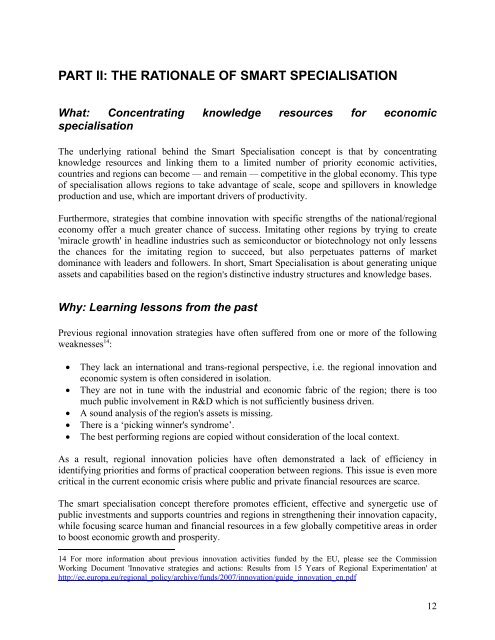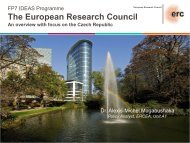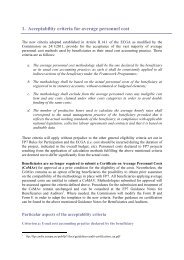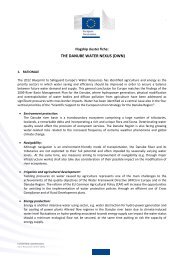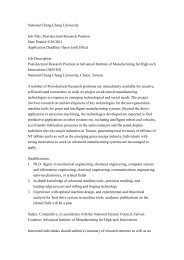Guide to Research and Innovation Strategies for Smart Specialisation
Guide to Research and Innovation Strategies for Smart Specialisation
Guide to Research and Innovation Strategies for Smart Specialisation
You also want an ePaper? Increase the reach of your titles
YUMPU automatically turns print PDFs into web optimized ePapers that Google loves.
PART II: THE RATIONALE OF SMART SPECIALISATION<br />
What: Concentrating knowledge resources <strong>for</strong> economic<br />
specialisation<br />
The underlying rational behind the <strong>Smart</strong> <strong>Specialisation</strong> concept is that by concentrating<br />
knowledge resources <strong>and</strong> linking them <strong>to</strong> a limited number of priority economic activities,<br />
countries <strong>and</strong> regions can become — <strong>and</strong> remain — competitive in the global economy. This type<br />
of specialisation allows regions <strong>to</strong> take advantage of scale, scope <strong>and</strong> spillovers in knowledge<br />
production <strong>and</strong> use, which are important drivers of productivity.<br />
Furthermore, strategies that combine innovation with specific strengths of the national/regional<br />
economy offer a much greater chance of success. Imitating other regions by trying <strong>to</strong> create<br />
'miracle growth' in headline industries such as semiconduc<strong>to</strong>r or biotechnology not only lessens<br />
the chances <strong>for</strong> the imitating region <strong>to</strong> succeed, but also perpetuates patterns of market<br />
dominance with leaders <strong>and</strong> followers. In short, <strong>Smart</strong> <strong>Specialisation</strong> is about generating unique<br />
assets <strong>and</strong> capabilities based on the region's distinctive industry structures <strong>and</strong> knowledge bases.<br />
Why: Learning lessons from the past<br />
Previous regional innovation strategies have often suffered from one or more of the following<br />
weaknesses 14 :<br />
• They lack an international <strong>and</strong> trans-regional perspective, i.e. the regional innovation <strong>and</strong><br />
economic system is often considered in isolation.<br />
• They are not in tune with the industrial <strong>and</strong> economic fabric of the region; there is <strong>to</strong>o<br />
much public involvement in R&D which is not sufficiently business driven.<br />
• A sound analysis of the region's assets is missing.<br />
• There is a ‘picking winner's syndrome’.<br />
• The best per<strong>for</strong>ming regions are copied without consideration of the local context.<br />
As a result, regional innovation policies have often demonstrated a lack of efficiency in<br />
identifying priorities <strong>and</strong> <strong>for</strong>ms of practical cooperation between regions. This issue is even more<br />
critical in the current economic crisis where public <strong>and</strong> private financial resources are scarce.<br />
The smart specialisation concept there<strong>for</strong>e promotes efficient, effective <strong>and</strong> synergetic use of<br />
public investments <strong>and</strong> supports countries <strong>and</strong> regions in strengthening their innovation capacity,<br />
while focusing scarce human <strong>and</strong> financial resources in a few globally competitive areas in order<br />
<strong>to</strong> boost economic growth <strong>and</strong> prosperity.<br />
14 For more in<strong>for</strong>mation about previous innovation activities funded by the EU, please see the Commission<br />
Working Document 'Innovative strategies <strong>and</strong> actions: Results from 15 Years of Regional Experimentation' at<br />
http://ec.europa.eu/regional_policy/archive/funds/2007/innovation/guide_innovation_en.pdf<br />
12


